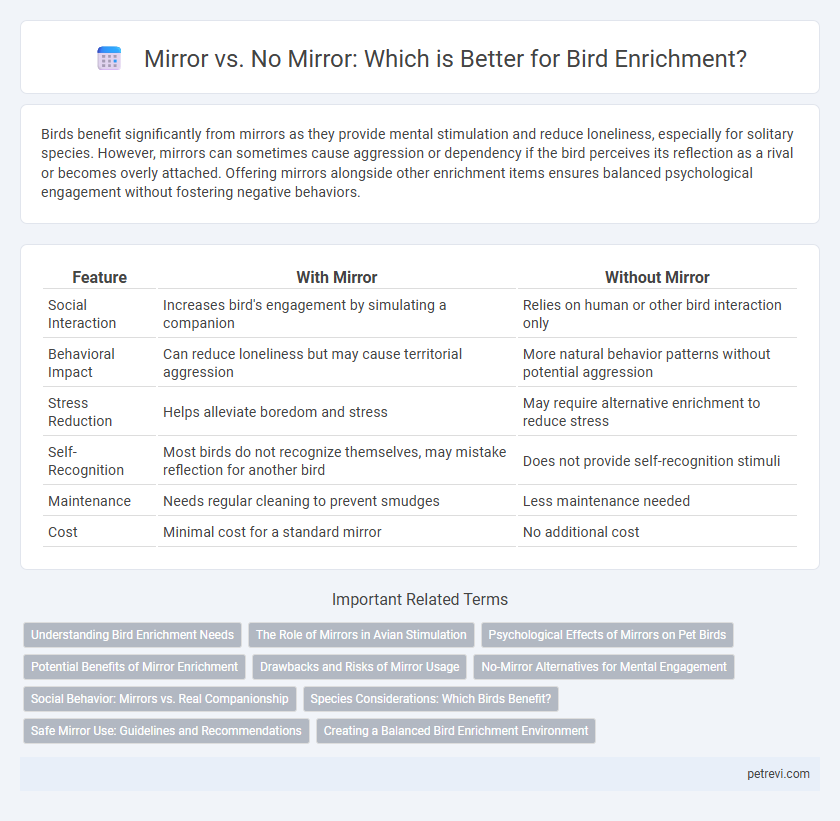Birds benefit significantly from mirrors as they provide mental stimulation and reduce loneliness, especially for solitary species. However, mirrors can sometimes cause aggression or dependency if the bird perceives its reflection as a rival or becomes overly attached. Offering mirrors alongside other enrichment items ensures balanced psychological engagement without fostering negative behaviors.
Table of Comparison
| Feature | With Mirror | Without Mirror |
|---|---|---|
| Social Interaction | Increases bird's engagement by simulating a companion | Relies on human or other bird interaction only |
| Behavioral Impact | Can reduce loneliness but may cause territorial aggression | More natural behavior patterns without potential aggression |
| Stress Reduction | Helps alleviate boredom and stress | May require alternative enrichment to reduce stress |
| Self-Recognition | Most birds do not recognize themselves, may mistake reflection for another bird | Does not provide self-recognition stimuli |
| Maintenance | Needs regular cleaning to prevent smudges | Less maintenance needed |
| Cost | Minimal cost for a standard mirror | No additional cost |
Understanding Bird Enrichment Needs
Bird enrichment requires recognizing species-specific social behaviors; many parrots benefit from mirrors as they simulate companionship and reduce loneliness, enhancing mental stimulation. However, some birds may become stressed or aggressive toward reflections, indicating that mirrors are not universally effective for all species. Providing alternative enrichment such as interactive toys, foraging activities, and environmental variability better aligns with diverse bird enrichment needs.
The Role of Mirrors in Avian Stimulation
Mirrors serve as a significant enrichment tool for birds, offering visual stimulation that can reduce feelings of loneliness and boredom, especially in solitary species like parrots. They simulate social interaction by reflecting the bird's image, which can encourage vocalization, play, and preening behaviors, enhancing mental engagement. However, reliance on mirrors should be balanced with other enrichment forms, as some birds might develop obsessive behaviors or aggression toward their reflection.
Psychological Effects of Mirrors on Pet Birds
Mirrors can provide significant psychological stimulation for pet birds by simulating companionship and reducing feelings of loneliness, especially in single-bird households. However, excessive mirror exposure may lead to obsessive behaviors, territorial aggression, or confusion between reflection and real birds. Balancing mirror use with varied enrichment activities helps promote mental health without causing stress or behavioral issues in pet birds.
Potential Benefits of Mirror Enrichment
Mirror enrichment for birds can stimulate social behaviors by providing visual interaction that mimics companionship, reducing feelings of loneliness and boredom. It encourages vocalizations and physical activity, which promote mental and physical well-being. Research indicates that mirror exposure can decrease stress-related behaviors and enhance cognitive engagement in solitary birds.
Drawbacks and Risks of Mirror Usage
Mirror usage for bird enrichment can lead to behavioral issues such as aggression, territorialism, and frustration due to birds mistaking their reflection for a rival. Prolonged exposure to mirrors may cause stress, social isolation, and repetitive behaviors that negatively impact mental health. Some species may develop dependency on mirrors, reducing natural social interactions and hindering overall well-being.
No-Mirror Alternatives for Mental Engagement
No-mirror alternatives for bird enrichment include interactive toys, puzzle feeders, and natural foraging activities that better stimulate cognitive functions and prevent boredom. These options promote natural behaviors and reduce the risk of aggression or self-harm often linked to mirror use. Integrating diverse, rotating challenges enhances mental engagement and overall well-being in captive birds.
Social Behavior: Mirrors vs. Real Companionship
Mirrors can stimulate birds by providing visual interaction that mimics social presence, often reducing loneliness and boredom. However, real companionship from another bird fosters authentic social behaviors, such as mutual preening and vocal communication, which mirrors cannot replicate. Studies show that while mirrors offer temporary enrichment, birds with live companions exhibit healthier psychological and social development overall.
Species Considerations: Which Birds Benefit?
Certain bird species, such as parrots and cockatiels, benefit significantly from mirror enrichment as it can provide social stimulation and reduce loneliness in single-housed birds. However, species like budgerigars may develop obsessive behaviors or aggression when exposed to mirrors for prolonged periods. It is essential to assess individual bird temperament and species-specific social needs before introducing mirrors to ensure positive enrichment outcomes.
Safe Mirror Use: Guidelines and Recommendations
Safe mirror use for bird enrichment involves ensuring mirrors are made from non-toxic, shatterproof materials to prevent injury and ingestion hazards. Position mirrors to avoid excessive reflection that may cause stress or aggressive behavior, and limit mirror access to short periods to encourage healthy interaction. Regularly inspect mirrors for damage and replace them promptly to maintain a secure environment conducive to positive bird enrichment.
Creating a Balanced Bird Enrichment Environment
In bird enrichment, incorporating mirrors can stimulate social interaction and reduce loneliness, especially for solitary species like parrots. However, excessive mirror exposure may lead to territorial aggression or confusion, suggesting that mirror use should be limited and combined with varied stimuli such as foraging toys and natural perches. Balancing mirror presence with diverse enrichment tools promotes mental health and prevents behavioral issues in captive birds.
Mirror vs No mirror for Bird enrichment Infographic

 petrevi.com
petrevi.com